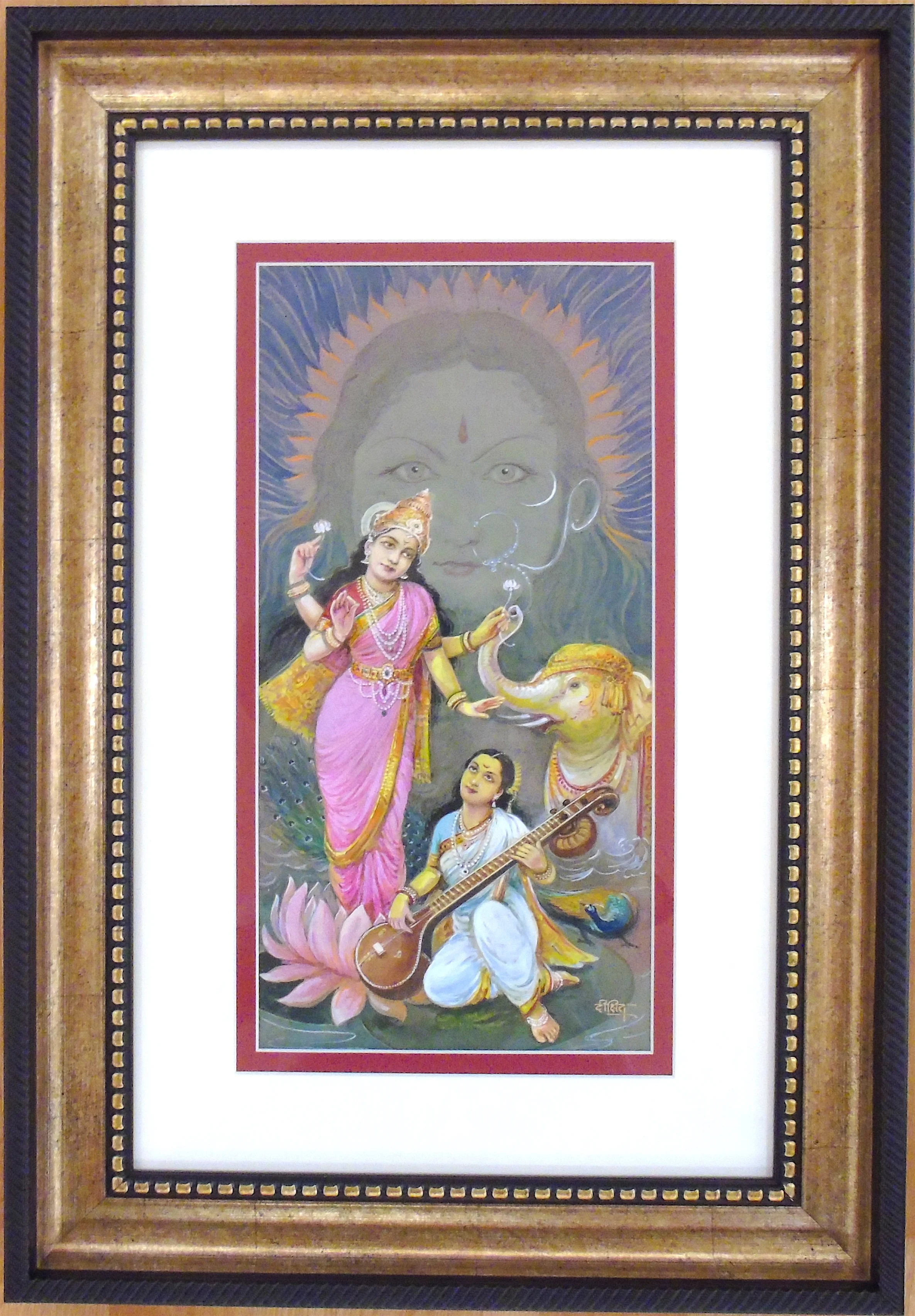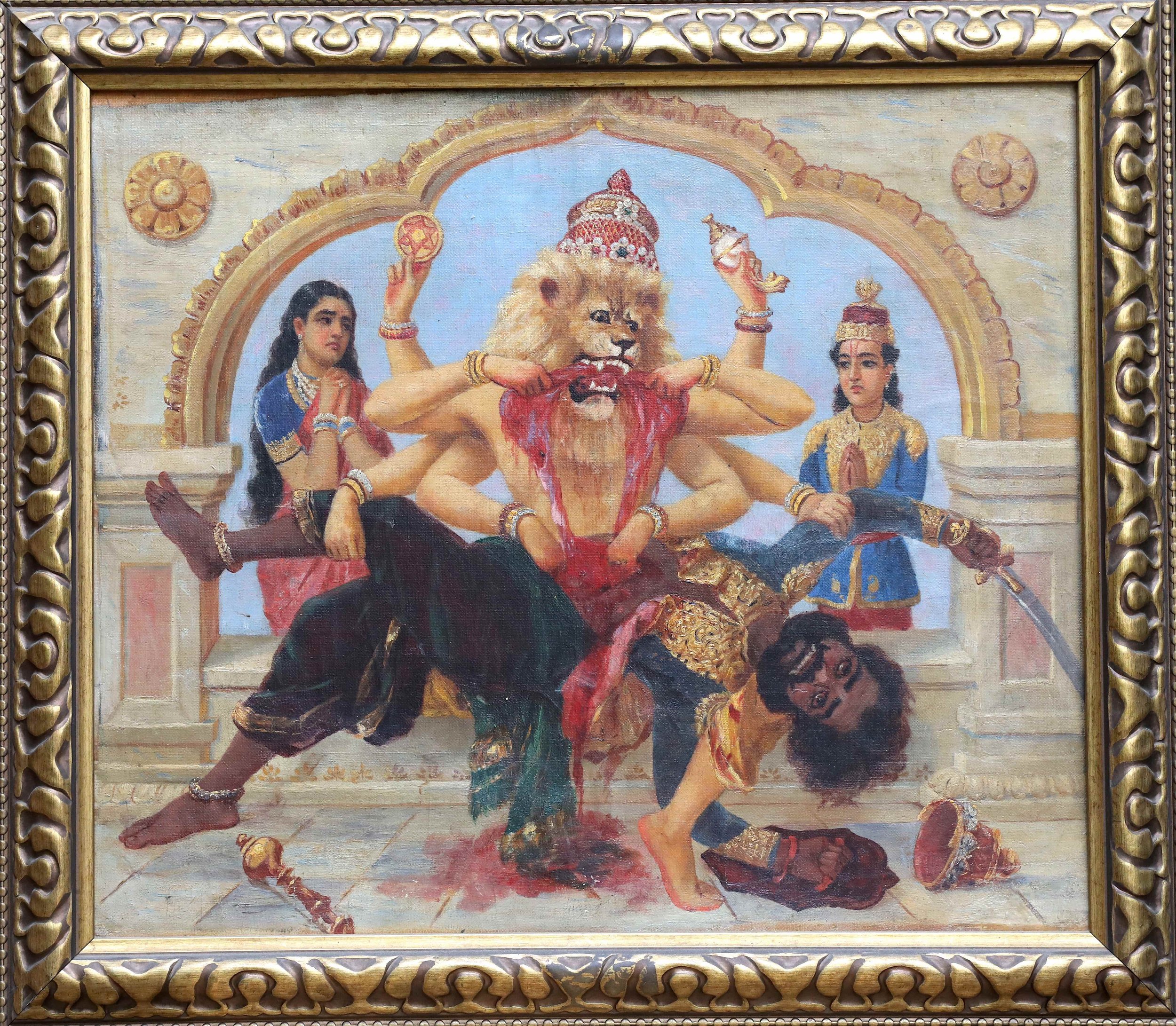A Century of Artistic Synthesis and Reinterpretations
“An untitled Dutch Bengal Painting”. Courtesy: gallery g
At Bengaluru’s gallery g, an exhibition of India’s artistic century journey from 1850 to 1950 presents a complex synthesis, resulting from the cross-pollination of old and new, Indian and European, traditional and innovative.
The pictured scene itself is perfectly commonplace. A portrait of Lord Krishna, frolicking in the gardens of Vrindavan amidst gopis. But this untitled painting—perched in the ‘Bengal’ section of the gallery—is truly unique. The untitled Dutch Bengal painting, done by an unidentified European artist with the help of an Indian art assistant, is estimated to have been created around 1850 and is probably one of the earliest oil paintings ever done in India.
Lakshmi Saraswati Shakti by Jiyaji Bhikaji Dikshit. Courtesy: gallery g
Keeping this piece company in the ‘Maharashtra’ section is Lakshmi Saraswati Shakti by Jivaji Bhikaji Dikshit, a painting that shows a trio of goddess, Mother Goddess Shakti and her two daughters Lakshmi and Saraswati, in a style reminiscent of master artist Raja Ravi Varma and contemporary S.M. Pandit from Kalburgi, Karnataka.
Then, moving on to the ‘Travancore’ section is Narasimha by Raja Ravi Varma that shows Vishnu—in the Narasimha avatar—as he kills King Hiranyakashyapa. The painting is part of Varma’s series on the ten avatars of Vishnu.
Shift now to the ‘Thanjavur’ and ‘Mysore’ sections, where one sees Portrait of Puttamma by K. Kesavayya, is a painting of the wife of Diwan Bahadur K Ramaswamy, a close associate of HH Maharaja Krishnaraja Wadiyar IV. This section also includes the moving image, Meeting of Father & Son by B.P. Banerjee, one that depicts a scene where the goddess Ganga introduces her son Devavrata to his father Shantanu for the first time. This chromolithographic print was first painted by an Indian artist, and then printed in Germany.
The common thread that flows through these paintings is that they chronicle the story of the evolution of Indian art and the country’s artistic legacy for a period of hundred years, between 1850 to 1950, as part of the show ‘Revelation and Reverences’ at Bengaluru’s gallery g (on view at until February 28, 2023). The gallery has chosen to display artworks from five of the most important zones that were hotbeds for art and artistic development during that time: Bengal, Maharashtra, Travancore, Thanjavur, and Mysore. The display then exhibits how the image moved beyond Indian shores and got reinterpreted uniquely at the hands of artists from Europe.
The range of paintings that emerged from this complex mix came to be known as ‘Early Bengal Oils’. The brilliance of Early Bengal paintings perhaps comes from the richness of old Indian miniatures which were compositions of powder tempera and indigenous pigments.
Much of the work displayed at this exhibition is from the gallery’s own collection. But the gallery has also sourced important oil paintings by Raja Ravi Varma and his contemporary artists through the Raja Ravi Varma Heritage Foundation, which have been loaned from various collectors. The Sandeep & Gitanjali Maini Foundation has given its entire collection of chromolithographs for display. They have borrowed old terracotta dolls from Ashvitas in Chennai for display.
The ‘Bengal’ zone features some of the most exciting work at the exhibition. “During the Raj, European painters did not focus only on landscapes, but also brought forth a novel brand of Indian art,” says Gitanjali Maini, founder and director of gallery g, who is also the founder trustee of Sandeep & Gitanjali Maini Foundation and managing trustee and CEO of the Raja Ravi Varma Heritage Foundation, says. “Bengal’s aristocrats invited artists over to their homes and asked them to paint on mythological and religious subjects and portraits of the families in their own technique. This was the oil on canvas style which was an unfamiliar genre in the Indian art scene. Since the Westerners drew much inspiration from Indian miniatures for the mythological works, they banked on Indian miniature artists to paint the figures.”
In the process, Indian miniature artists picked up the handling of oil paintings. The range of paintings that emerged from this complex mix came to be known as ‘Early Bengal Oils’. The brilliance of Early Bengal paintings perhaps comes from the richness of old Indian miniatures which were compositions of powder tempera and indigenous pigments. There are two original works by M.V. Dhurandhar, one of the most important artists from Maharashtra, from his ‘Women of India’ collection which was monogrammed and edited by Otto Rothfield, the District Collector of Alibaugh, an art enthusiast and scholar.
Narasimha by Raja Ravi Varma. Courtesy: gallery g
The artists and artworks were chosen based on the people who were active and prominent during that time. “We also chose to focus closely on how Hindu iconography evolved and developed in these zones,” Maini says. “Hence many of the works on display are chromolithographs and early lithographs of gods and goddesses. This also clearly documents and showcases India’s print legacy and how that genre of art evolved and developed in this 100-year period.” While the cities may seem very different from each other, every region fed off the other and one place’s influence on the next can be clearly seen in this exhibition.
“What was region specific to Bengal was interpreted in a localized manner in Maharashtra and similarly in Travancore, Thanjavur, and Mysore,” Maini adds. “The face of Lakshmi, slightly oriental in Bengal, took on a gracefulness and slightly western features when painted by a Travancore artist. The same Lakshmi looks more south Indian when painted by a Tamil artist, with her saree, jewellery and features being locally influenced. The entire country was interconnected through art and culture—and still is.”
Beginning with Kalighat sketches and moving on to Early and Dutch Bengal paintings, and to modern interpretation of traditional art through Jamini Roy’s artwork, the Bengal journey also takes the visitor through to a collection of works by latter day artists who persevere in the difficult art of Tempera on different mediums.
The Maharashtra journey, meanwhile, features the chromolithographs of popular gods and goddesses, before moving on to watercolour works by Jivaji Bhikaji Dikshit, a painter and illustrator who became popular designing covers for religious books and magazines. “All through, the common theme in this exhibit is stories and characters from the epics, save for the portrait study based on A.X. Trinidad’s work by current day artist Sunil Tambe,” says Maini. “The parallel we draw to this portrait will become clear as you make your way into the next section, the biggest and boldest of them all, showcasing original oil works, chromolithographs, and other artefacts from Travancore.”
Meeting of Father & Son by B.P. Banerjee. Courtesy: gallery g
The Travancore exhibit, without doubt, is the piece de resistance of ‘Revelation and Reverences’, featuring original oil paintings by the master artist and chromolithographs of some of his other works. It also showcases original paintings by his contemporaries or artists who evolved in what was to eponymously become the ‘Ravi Varma School of Painting’.
Stone blocks. or litho stones, used for the purpose of producing chromolithographs, have been specially sourced and featured in this exhibit to give a better insight and understanding of how the prints were made from these blocks. “We not only trace the iconography of the deities, we also chart how the image moves from one medium to another emerging as antique terracotta dolls, borrowed ostensibly from Ravi Varma’s themes and iconography,” says Maini.
In the colonial setting, nearly all the artists incorporated European artistic elements—consciously or otherwise. Some had received training in art schools established by the British where they had been instructed in single-point perspective of ’realistic’ painting. This would soon resonate in the Indian film industry which exerted a huge influence on the depiction of the deities. At the same time, older conventions of iconography and well-known narratives retained their central role in the way deities were depicted. The result was a complex artistic synthesis, resulting from the cross-pollination of old and new, Indian and European, traditional, and innovative, that would prove enormously popular throughout the subcontinent. And it is this wide-ranging journey through time and art experienced this 100-year trip, one that has set the tone for the next century.
***
Bindu Gopal Rao is a freelance writer and photographer based in Bengaluru. She is passionate about all things to do with the environment. You can follow her on Instagram @bindugopalrao.




